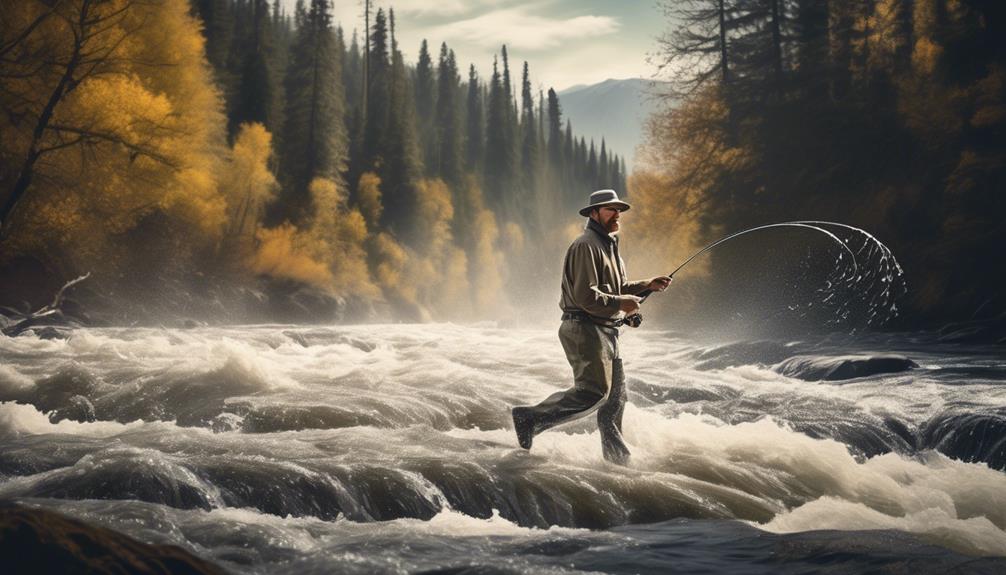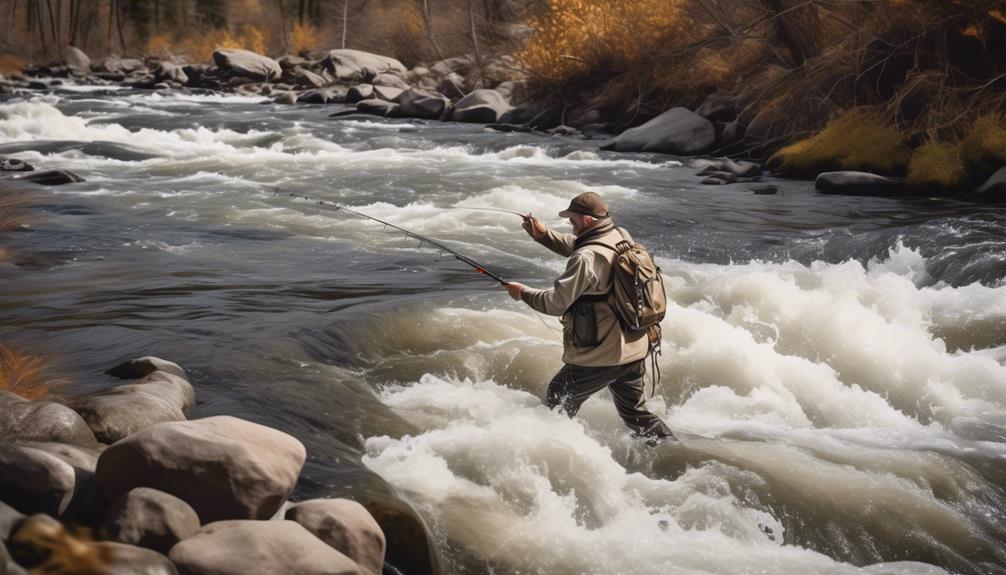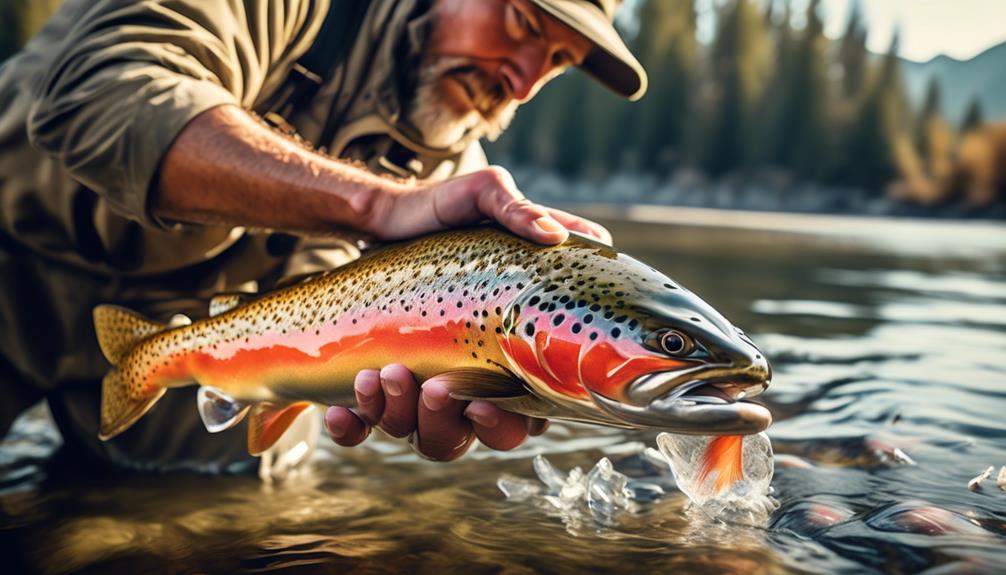When fly fishing for steelhead in rapids, it's like trying to navigate a maze with a prize waiting at the end. The challenge lies in understanding the behavior of these elusive and powerful fish and adapting your techniques to match their movements.
With the rush of the water and the thrill of the hunt, mastering the art of fly fishing for steelhead in rapids requires a blend of skill, strategy, and patience.
So, how can you effectively lure these prized fish in such dynamic and unpredictable conditions?
Understanding Steelhead Behavior
To successfully catch steelhead in rapids, it's crucial to understand their behavior and movement patterns.
Steelhead, a type of trout, are well-known for their spawning behavior and migration. Understanding their spawning behavior is essential because it affects their feeding habits and territoriality. During spawning season, steelhead tend to become more territorial and aggressive, as they establish and defend their spawning territory. This territorial behavior can be advantageous for anglers, as it provides insight into where steelhead might be located and how they may respond to different fly presentations.
Migration plays a vital role in steelhead behavior as well. These fish are known for their remarkable ability to navigate through various water conditions to reach their spawning grounds. As they migrate, steelhead often pause in areas with specific characteristics that provide suitable conditions for resting and feeding. Rapids can serve as natural resting and feeding areas for steelhead during their migration. Understanding their migration patterns can therefore help fly fishers identify prime locations for targeting steelhead in rapids.
In terms of feeding habits, steelhead are opportunistic feeders, preying on a variety of aquatic insects, small fish, and crustaceans. Their feeding behavior can change depending on factors such as water temperature and flow, which can affect their activity level and willingness to take a fly. Additionally, understanding their territoriality can provide insights into their behavior, helping fly fishers anticipate how steelhead may react to different fly presentations.
Selecting the Right Flies
Selecting the right flies for steelhead fishing in rapids is crucial for increasing your chances of a successful catch. When it comes to fly selection, it's important to consider the specific conditions of the rapids. Steelhead in rapids are often more aggressive and opportunistic, so your fly choice and presentation need to match their behavior.
Fly selection for steelhead in rapids should focus on patterns that imitate the local aquatic insects and baitfish. Effective flies for rapids include streamers, nymphs, and egg patterns. Streamers are particularly effective for aggressive steelhead in fast-moving water, while nymphs and egg patterns work well in slower pockets within the rapids.
When considering fly patterns, it's essential to understand the local insect hatches and the types of baitfish present in the rapids. This knowledge will help you choose or tie flies that closely resemble these natural food sources. Fly tying allows you to customize your flies to match the specific characteristics of the insects or baitfish in the area, giving you a distinct advantage when presenting your fly to steelhead in rapids.
In terms of presentation, it's crucial to accurately mimic the movement and behavior of natural prey. This may involve using a varied retrieval technique to simulate the erratic movements of injured baitfish or the drifting behavior of nymphs in the water column. By carefully selecting your flies and mastering their presentation, you can significantly improve your success when fly fishing for steelhead in rapids.
Navigating Rapids Safely
Navigating rapids safely demands a keen understanding of the water's dynamics and potential hazards, which is essential for maximizing your fly fishing experience for steelhead. To ensure a safe and enjoyable fishing trip, consider the following river safety and rapid navigation tips:
- Scout the Rapids: Before entering a rapid, take the time to scout the area from the riverbank. Look for any potential obstacles, such as large rocks or fallen trees, and assess the current and its strength. Understanding the layout of the rapids will help you plan your route and avoid dangerous areas.
- Maintain Proper Positioning: When maneuvering through rapids, always maintain a proper position in your watercraft. Keep your boat perpendicular to the current to reduce the risk of capsizing. Additionally, stay alert and be prepared to adjust your course as needed to navigate around obstacles.
- Use Proper Safety Gear: Prioritize safety by wearing a personal flotation device and appropriate safety gear. In the event of an unexpected situation, having the right gear can make a significant difference. Additionally, consider using a helmet to protect your head from potential impacts during rapid navigation.
Drifting Techniques for Steelhead
When targeting steelhead, mastering effective drifting techniques is essential for increasing your chances of a successful catch. Streamside observation plays a crucial role in identifying feeding patterns. Look for areas where steelhead gather to feed, such as seams, eddies, and pockets behind rocks or other structures in the water. Observe the behavior of the steelhead to determine the speed and depth at which they're feeding. By understanding their feeding patterns, you can better position your drift to entice a strike.
Timing your drifts and adjusting for water speed is another vital aspect of successful steelhead fishing. Pay attention to the speed of the current and make adjustments to your drift to ensure that your bait or fly is presented naturally. This may involve casting slightly upstream and allowing your bait to drift downstream at the same speed as the current, mimicking the natural movement of prey in the water.
Additionally, varying the depth of your presentation to match the water column where steelhead are actively feeding can significantly improve your chances of a hookup.
Reading Water Currents Effectively
To effectively read water currents when fly fishing for steelhead, observe the flow patterns and look for areas where the current slows or changes direction. Steelhead often hold in specific areas within the river, and understanding water currents can help you target these prime locations.
Here are three key techniques to help you read water currents effectively:
- Identifying eddy pockets: Eddy pockets are areas where the current reverses or slows down, creating a calm pocket of water. These are often found behind large rocks, along the edges of the river, or near obstructions. Steelhead tend to seek refuge in these eddy pockets to conserve energy and find shelter, making them important spots to target. Look for swirls, foam lines, or debris accumulation on the water's surface, as these can indicate the presence of eddies.
- Analyzing river flow: Understanding the overall flow of the river is crucial for locating steelhead. Observe the surface of the water to identify fast-flowing sections, riffles, and deeper, slower-moving pools. Steelhead migrate through these different flow zones, and being able to analyze the river flow will help you predict where they're likely to hold. Additionally, pay attention to any changes in the river's depth, as variations in depth can influence the speed and direction of the current.
Utilizing Spey Casting Methods
Using spey casting methods can greatly improve your ability to reach distant steelhead lies while maintaining tight control over your fly's presentation. Spey casting has several advantages that make it particularly effective for fishing in rapids and fast-flowing waters.
One key advantage is the ability to cover a large area of water efficiently. By utilizing the extended reach of a two-handed spey rod, you can effectively fish areas that are difficult to reach with traditional casting methods. This is especially beneficial when targeting steelhead holding in the deeper runs and pockets within rapids.
Spey casting techniques also enable you to present your fly in a more natural and drag-free manner. The ability to mend the line effectively during the swing allows for a longer and smoother presentation, increasing the chances of enticing a steelhead to strike. Additionally, the D-loop formed during the spey cast generates significant line speed, allowing for effortless distance and control, crucial for navigating the complexities of rapids.
To successfully utilize spey casting in rapids, it's essential to master the various spey casts, such as the Single Spey, Double Spey, and Snake Roll. These casts provide the versatility needed to adapt to different river conditions and casting angles, ensuring that you can effectively cover the water and present your fly precisely where the steelhead are likely to hold.
Mastering the Wet Fly Swing

Master the wet fly swing for effectively enticing steelhead in rapids and fast-flowing waters. This technique involves presenting the fly at the right depth and speed, and timing the swing to mimic the movement of natural prey.
To master the wet fly swing, keep the following tips in mind:
- Fly Presentation: When executing the wet fly swing, it's crucial to present the fly in a way that mimics the movement of aquatic insects or baitfish. Allow the fly to swing across the current, imparting a lifelike action to entice steelhead. Vary the speed and depth of the fly presentation to find the most effective pattern for the given conditions. Steelhead often key in on specific movements, so experimenting with different presentations can help you dial in on what the fish are responding to.
- Timing: Timing is essential when mastering the wet fly swing. Allow the fly to sink to the appropriate depth before beginning the swing. As the fly swings across the current, pay attention to the timing of the swing and the movement of the fly. Steelhead are often triggered by a perfectly-timed swing that presents the fly at the optimal moment, so be attentive to the behavior of the fish and adjust your timing accordingly.
- Water Depth and Speed: Understanding the water depth and speed is crucial for a successful wet fly swing. Adjust the length of line and the angle of the swing to match the depth and speed of the water. By adapting to the specific conditions, you can ensure that the fly is moving naturally and enticingly, increasing the likelihood of enticing steelhead to strike.
Handling Steelhead With Care
When landing steelhead, it's essential to handle them with care to ensure their health and survival after being caught. Proper handling and conservation techniques are crucial in protecting steelhead and promoting ethical angling practices.
Once you've successfully hooked a steelhead, the way you handle it can significantly impact its well-being. Firstly, always wet your hands before touching the fish. This helps protect their delicate mucous layer, which is vital for their protection against diseases and parasites. Avoid using a cloth or towel to handle the fish as it can remove this protective layer.
When handling the fish, support its body properly to avoid unnecessary stress or injury. Cradling the fish gently and keeping it in the water as much as possible while unhooking or taking a quick photo can greatly improve its chances of survival upon release.
Additionally, if you need to handle the fish out of water, do so for the shortest time possible, and make sure to release it in an area with strong, oxygenated water flow. When practicing catch and release, it's important to minimize the time the fish is out of the water and to revive it by gently holding it upright in the water until it swims away under its own power.
Frequently Asked Questions
What Are the Best Locations for Finding Steelhead in Rapids?
When fly fishing for steelhead in rapids, look for spots with deep pockets and boulders where they can rest. Cast upstream and let your fly drift naturally. Use bright or dark fly patterns to entice strikes.
How Can I Effectively Present My Fly to Steelhead in Fast-Moving Water?
When fly fishing for steelhead in fast-moving water, focus on fly presentation. Adjust your casting angle to match the water speed and target areas where steelhead feed. Use short, controlled drifts to entice strikes.
What Are Some Common Mistakes to Avoid When Fishing for Steelhead in Rapids?
When fishing for steelhead in rapids, common mistakes to avoid include not reading the water properly and using the wrong presentation. By learning proper technique and understanding the river's flow, you can improve your success.
Are There Any Specific Gear or Equipment Recommendations for Fishing Steelhead in Rapids?
When fishing for steelhead in rapids, you'll want gear that can handle the strong currents and aggressive fish. Look for sturdy rods, reels with smooth drag systems, and weighted lines to help you navigate the fast water. Use techniques that allow your fly to drift naturally in the current.
What Are Some Advanced Techniques for Targeting Larger Steelhead in Rapids?
To target larger steelhead in rapids, try advanced casting techniques and consider steelhead behavior. Use the right fly selection and understand river dynamics. It's crucial to adapt and anticipate the fish's movements for successful angling.
Conclusion
So, next time you're out on the river, remember to keep these effective techniques in mind for fly fishing steelhead in rapids.
By understanding steelhead behavior, selecting the right flies, navigating rapids safely, and mastering drifting and casting techniques, you'll be well-equipped to have a successful fishing trip.
And don't forget to handle steelhead with care to ensure their survival.
Happy fishing!



